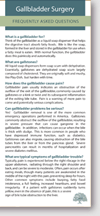Gallbladder Surgery
What is a gallbladder?
Think of the gallbladder as a liquid soap dispenser that helps the digestive tract absorb fatty foods. Bile is like the soap, formed in the liver and stored in the gallbladder for use when you eat a fatty meal. With normal function, the gallbladder does this painlessly and automatically.
What are gallstones?
All liquid soap dispensers form soap scum with dehydration. Essentially, gallstones are dehydrated soap scum largely composed of cholesterol. They are originally soft and mushy, like Play-Doh, but harden with time.
How does the gallbladder cause pain?
Gallbladder pain usually indicates an obstruction of the outflow of the exit of the Gallbladder, commonly caused by gallstones or a kink or twist and its subsequent inflammation of the exiting bile tube. Pain is a warning of more pain to come and potentially serious complications.
Can gallbladder problems be serious?
Yes! Gallbladder removal is one of the more common emergency operations performed in America. Gallstones commonly obstruct the outflow of the gallbladder, resulting in severe pressure that can cause gangrene in the gallbladder. In addition, infections can occur when the bile is thick with sludge. This is more common in people who have depressed immune function, such as diabetics. Gallstones can also migrate, causing obstruction of the bile tubes from the liver or from the pancreas gland. Severe pancreatitis can result in months of hospitalization and severe diabetes mellitus.
What are typical symptoms of gallbladder trouble?
Typically, those with gallbladder issues experience moderate to severe pain below the right ribcage in the upper abdomen, radiating through the right shoulder and back. Some patients experience pain after eating meals, while others suffer pain during the night, disrupting sleep for hours. Other common symptoms include burping, fatty
food intolerance, a full feeling, increased heartburn, and bowel irregularity. If a patient with gallstones suddenly turns yellow, even in the absence of pain, this is a severe sign of bile tube obstruction to the liver.
Can this be managed without surgery?
A low-fat diet may result in less frequent and less intense symptoms. For those who have attacks at night, sleeping on the right side may make those attacks less frequent. Pills are available to dissolve gallstones, although the pills are generally toxic to the liver and may take six months to two years to dissolve the stones. Until the late 1980s, an alternative treatment known as lithotripsy was employed to crush gallstones; but this method is not currently used.
Is minimally invasive surgery available?
The standard form of treatment for symptomatic gallbladder trouble is laparoscopic cholecystectomy. This is usually an outpatient surgery under general anesthesia, where a tiny TV camera is introduced into the abdomen through an incision near the navel. Three more small incisions allow the surgeon to work in the abdominal cavity without opening the abdomen. The operation usually takes around an hour, and during the operation, x-rays are usually taken of the bile tubes to make sure that there are no migrating gallstones left behind.
What is recovery like?
This is usually an outpatient surgery and nausea and discomfort are most bothersome in the first 24 to 48 hours. After that, a low-fat diet is advised for a few months to minimize indigestion relating to adjustment to digestion without the gallbladder. Most people are able to discontinue pain medicine and resume driving within a week and can return to light-duty work within a week. We advise that you don’t lift more than 15 pounds for about a month.
Choosing a surgeon is an important and personal decision. You should consider a surgeon’s experience and the techniques he or she uses in the specific surgery you need. The surgeon’s bedside manner, scheduling availability and costs are also important factors in your decision. Dr. Wright has performed nearly 4,000 minimally invasive laparoscopic gallbladder surgeries. He performed many of these as day surgeries in his Meridian Surgery Center. This convenient option provided his patients with excellent care and privacy with less exposure to hospital related risks.
Meridian Surgery Center and Cascade Hernia Institute are conveniently located in the heart of Pierce County, just south of Seattle and east of Tacoma, in the city of Puyallup, Wash.


